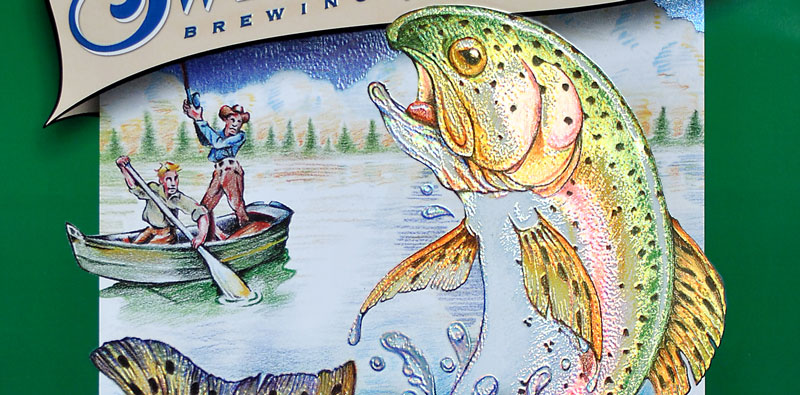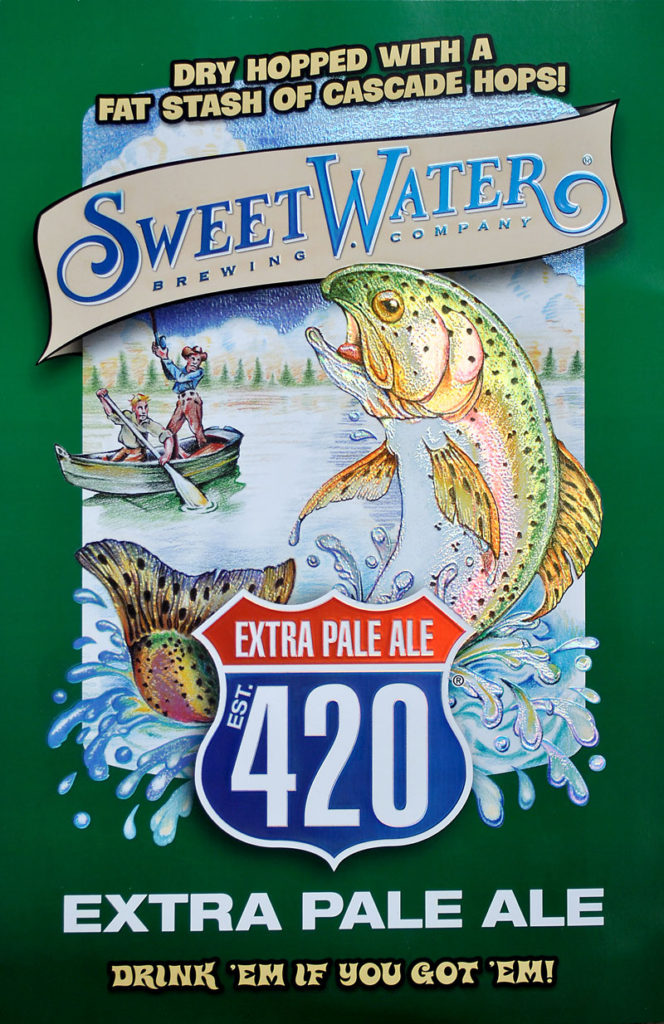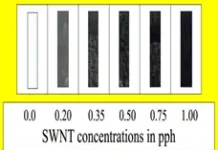by Lara Copeland, contributing editor, UV+EB Technology
Although its slogan states, “We’re not here for a long time, we’re here for a good time,” SweetWater Brewing Company, based in Atlanta, Georgia, first hit the beer scene more than 20 years ago. The brewery’s most popular beer, 420 Extra Pale Ale, was named for the first time it was ever brewed – April 20, 1997. Head brewer Nick Nock describes the beer as the “brew everybody goes to.” This West Coast-style pale ale is recognizable by the large rainbow trout featured on many of the company’s labels. The trout is front and center, located behind an interstate sign featuring the beer’s name.
SweetWater wanted to create a point-of-sale (POS) poster that would show off the look of its 420 Extra Pale Ale and the iconic trout. The company called on Digital Marketing Services (DMS), Inc, Pelham, Alabama – a digital printing company that combines digital printing, graphic design and new embellishment technologies – to help.
“We were asked to enhance the poster by adding our input for foil and UV varnish placement as a finishing technique,” said David Rula, DMS business development director. “SweetWater needed to produce enough posters for distribution across several regions in the US. The poster was going to be hung in POS locations where it would be more visible and eye-catching to increase customer awareness.”
Between the SweetWater Brewing Company banner that adorns the top third of the poster and the rainbow trout placed in the front are two fishermen in a canoe, and one appears to be reeling in the trout while the other paddles. These graphics were provided by the client; however, DMS still faced a challenge. “Because the finishing process is digital, we had to use the graphics provided as a base for our own design of the spot channels for laydown of foil and UV varnish,” Rula explained.
The first step in the process was applying the holographic foil onto the paper stock (McGregor #130 Gloss Cover). “Using the MGI JetVarnish 3DS, we laid down the UV-curable adhesive directly onto the substrate where we wanted the foil to appear,” Rula explained. “Then, at a separate station on the MGI machine, the Crown Roll Leaf seamless holographic foil was applied.” An LED curing station was used to cure the adhesive prior to foil application.
Once DMS put down the initial UV adhesive and foil, the image was sent to the Konica Minolta C1100 Digital Press for a complete registered CMYK overprint procedure. “The difference between this procedure and a regular print procedure is that the toner is printed over more than just paper substrate,” Rula said. The holographic foil was layered beneath the toner for the blue sky, the trout, the water drops surrounding the fish and the interstate sign. Once the toner was applied, the colors over the foil took on a dull, iridescent look.
From that point, “we sent the image back through the MGI JetVarnish 3DS for a top layer of gloss UV varnish and UV protectant,” Rula said. Again, an LED curing station was used to completely cure the final layer of varnish and protectant. This process, according to Rula, brings out the full range of effects of the overprinted holographic foil. “Everything now glistens and adds more dimension to the piece,” he concluded. The SweetWater poster included multiple passes on the MGI machine to build up the “embossed look” of the 420 sign – all in perfect registration.
Masking for the spot channels was a design challenge that the company welcomed. “This is where the creative spirit must play in a fun and free manner, but with the precision to place varnish and foil in the right setting for the maximum effect,” Rula suggested. Skills are put to the test when trying to find the balance between using too much or too little UV varnish. “It’s easy to say, ‘just varnish everything and make it all glisten,’ but in the end that’s too much,” he said. Likewise, the opposite also is true. Using too little UV varnish means the product remains plain and appears as though nothing was done. In addition to using the right amount, it also is key to know where to place the foil and varnish. “This is especially true when working with foil effects, varnish overlay and 3D varnish effects all in one design,” he confirmed.
Because the entire project from the UV varnish to the printing was digital, it did not require set-up plates, lengthy test warmups of rollers, etc., which are required for traditional offset. “If a mask is giving us trouble, be it registration or creative, we can easily change it in Adobe Photoshop® or Illustrator®,” Rula added. “In less than 10 minutes, we are running up a new proof to see if registration, foil effects or 3D effects have changed. Even better, we can switch out colors of foil in less than two minutes and be up and running for a new sample test.”
Customers “flipped” in response to the poster, Rula said. “SweetWater and its clients’ responses to seeing a rainbow trout actually look like a rainbow trout in print for the first time in history was akin to jaws hitting the floor.” In addition, according to Rula, finishing techniques using the embossed look of UV varnish are “awesome,” adding foil is “better” and digital printing is “great!” Putting them together in different combinations “is something that blows just about every customer’s mind away because it finally unlocks ways of creativity never imagined before.”
In addition to the customers’ praise, the SweetWater 420 poster also was celebrated by the printing industry. It earned a gold award in the Best Use of Digital UV Inkjet Coatings with Foil category at the 2018 Foil & Specialty Effects (FSEA) Gold Leaf Awards.
“This type of job for SweetWater Brewing Company is a great example of what our new abilities with UV varnish and foil can add,” Rula concluded. “The ability to offer these types of embellishments for our customers has opened up new doors and provided opportunities with higher-level premium customers that we never had in the past.”








